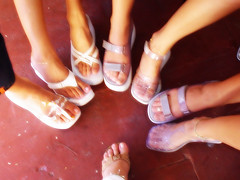Is there a relationship between foot posture and overuse injuries? Research is beginning to investigate the differences in foot motion between people.
| Feet (Photo credit: Prio) |
Pazit Levinger et al. reports in "A comparison of foot kinematics in people with normal- and flat-arched feet using the Oxford Foot Model" in the October 2010 edition of Gait and Posture that people with flat-arched feet have altered motion that is associated with greater pronation during gait. The researchers conclude that this may be one of the factors that may increase the risk of overuse injuries.
So what does this mean to us? In my opinion, the average older adult is more prone to foot posture issues as a result of aging. Therefore, this study provides more evidence for the active older adult to get their foot posture issues addressed by a medical professional.



